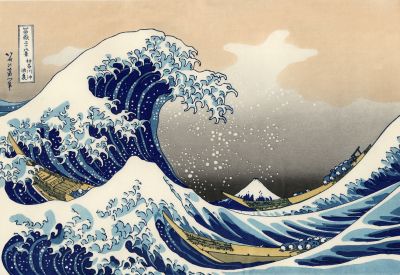The aftermath of a tsunami

The Great Wave off Kanagawa
Katsushika Hokusai (葛飾北斎) [Public domain], via Wikimedia Commons
A research background in earthquake engineering seems at first sight like an unusual fit with studying tsunamis. But on her return from Sri Lanka in the wake of the 2004 tsunami, Professor Tiziana Rossetto discovered that very little research had been done into the effects of tsunamis on coastal infrastructure and she wanted to find out more. She will be presenting this research to the public at the TEDx Brussels event on 1 December.
An ambitious exercise
Prof. Rossetto looks back at the origins of her current project as
the result of asking “Why not?” when told that tsunami waves could not
be simulated in the lab. She was also attracted to earthquake
engineering because it is a new science, and one in which an impact can
be made very tangibly. She says that “it allows us to contribute to a
revolution in how we design buildings. It combines engineering with
seismology, structural dynamics and even the social sciences.”
Her ERC-funded research looks at the damage caused by the impact of
tsunamis on buildings by modelling the horizontal force that hits
buildings during a tsunami, and studying how they react. Looking at the
load that buildings can withstand should teach us more about how we can
mitigate these forces. The aim is to improve sea defence systems, rather
than the buildings themselves, as it is more likely that these coastal
defence systems can be constructed and maintained in the areas of the
world that are affected by tsunamis, which tend to be developing
nations.
The devastating impact that tsunamis can have on infrastructure is
illustrated in very distinct ways by the cataclysmic effects of the
“Boxing Day” tsunami (2004) and the tsunami which hit Japan in 2011. In
the Indian Ocean crisis, whole communities were swept away by the waves.
In Japan, the tsunami caused the meltdown of three of Fukushima’s
nuclear reactors. In a finding of particular relevance for this project,
it was determined that the plant could have been better protected
against natural disaster. It is precisely this kind of planning which
interests Prof. Rossetto and her team.
Modelling a tsunami
The difficulties of this research are compounded by the fact that
there is little verified observational data on how tsunamis unfold, due
to the rarity of these events. The goal of this research is both to
experimentally investigate the transformation of a tsunami nearshore
and, alongside this, mathematically model the permutations which cannot
be physically modelled with any degree of ease. Originally Prof.
Rossetto was told that it was not possible to model the tsunami waves,
which are extremely long. This became a challenge, which was solved with
the building of a new type of pneumatic tsunami generator, which is not
limited by the piston capacity of traditional wave generators and which
can reproduce the extremely long wavelengths associated with tsunamis.
It is also the world’s only facility able to model trough-led tsunami
waves. The tsunami generator is mounted in a 70m long and 4m wide flume
at the laboratories of HR Wallingford in the UK. The flume is heavily
instrumented and enables the researchers to examine the interaction
between tsunami waves and coastal defence structures, individual
buildings and groups of buildings: more accurately mirroring what
happens in a real-life event.
Experiencing disaster
Prof. Rossetto’s research is both experimental and theoretical,
encompassing reconstructions and calculations of the tsunami wave and
its aftereffects, particularly modelling the fragility of buildings.
Calculating the insurance implications of a natural disaster on this
scale is a necessary part of the preparations from an infrastructure
perspective but there is another side to the insurance question. In a
related piece of research, Prof. Rossetto traced a global phenomenon:
“how do people living in at-risk areas approach potential disasters?
They are not ignorant of the risks, but they do very little to prepare.”
The ERC backing has been of enormous help to the project, not least
because of the attention it has attracted. She emphasizes: “On a
practical level it has ensured that I can concentrate on the work
uninterrupted. It has really opened doors because it is seen as such a
seal of quality for the work. It has led to conversations with
policy-makers and involvement in co-development projects: for example in
research collaborations and discussion to include tsunamis in the next
European building codes post-2020.”
Prof. Rossetto believes that her research will “spark imagination”
at TEDx Brussels. She observes that the combination of real-life threat
and hi-tech solutions produces a narrative that should grip the TEDx
audience. In the most practical way possible her aim is to “save lives,
and in doing so build a safer world for our children”.
Listen to Prof. Rossetto on 1 December at 2.15 pm (BOZAR, Salle Henry Le Boeuf)
published: 2015-01-27